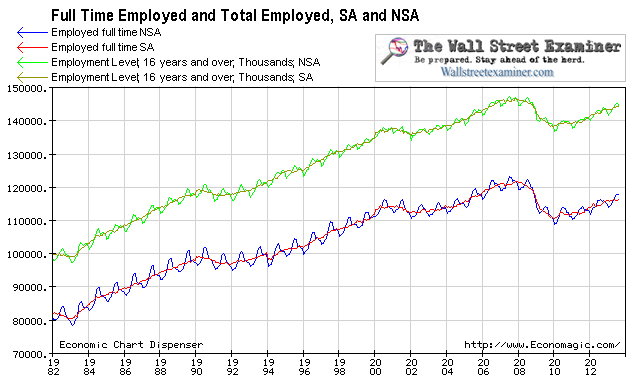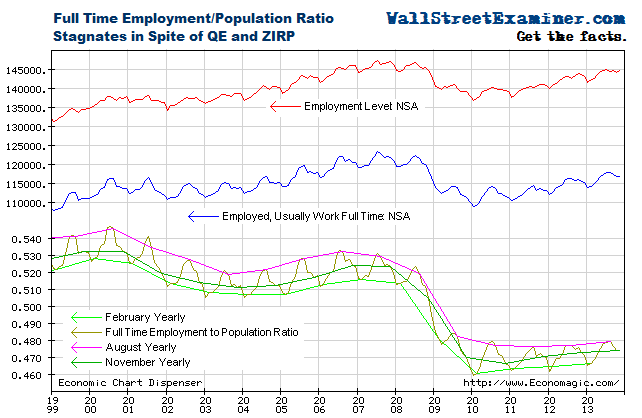Courtesy of Lee Adler of the Wall Street Examiner
In Part 1 of this report we looked at non-farm payrolls, which come from the BLS the Current Employment Statistics Survey or CES, a survey of business establishments. The BLS also does a survey of households. The household survey or CPS — Current Population Survey– sometimes tells a different story from the establishment survey. It’s also important in that it breaks out full time employment from total employment so that we can analyze that important metric separately.
The actual NSA (not seasonally adjusted) number of persons reported in the CPS as employed in April rose by 1.02 million from March. April always shows an increase, but this month was among the better increases compared with the past decade. The total employed increased by 583,000 in April last year, and by 699,000 in April 2011. The average change in April for the previous 10 years was an increase of 733,000. April this year was very good, but it was a rebound from an extremely poor March. Looking at a 3 month period, this year wasn’t as good as either 2012 or 2010, but was better than 2011. The overall pace of change appears to have slowed in the past year.
The year over year gain in total employment under the CPS was 1.72 million or 1.2%. This was up from 0.9% in March. The annual growth rate has decelerated from 2.2% last October. The growth rates were actually stronger before the Fed restarted pumping money into the economy in November than since it settled the first of its QE3 MBS purchases at that time.
Full time employment growth is also lagging. Government policies, particularly the Obamacare requirement that employers provide medical insurance for full time employees, have given employers incentives to cut worker hours. That artificially inflates total employment at the expense of full time employment.
Full time employment in the CPS rose by 878,000 in April, which is almost always an up month for full time jobs. Last year full time jobs rose by 83,000 in April, and in 2011 they rose by 658,000. The 10 year average increase in full time jobs for April was 639,000, pulled down by a negative number in 2007. This year’s April gain was better than that average, making up for a soft month in March.
The chart above gives some perspective on how far total employment and full time employment fell in the first stage of the 2008-09 depression, and how much they have yet to recover.
With QE3 in late 2012, the Fed began adding more fuel to an engine that was running at its natural capacity. Job growth has not accelerated in response to the flood of money printing. While house prices and stock prices are rapidly inflating thanks to too many dollars chasing too few assets, job growth has been tepid. The Fed is blowing massive asset bubbles while the economy plods along at the a growth rate little different from when it was in a long pause in QE in 2011 and 2012. Money printing works to inflate asset prices, but it appears to do nothing to stimulate job growth.
The chart below shows that while the number of jobs is growing, the full time employment to population ratio has barely budged since the recovery began in 2009. The economy seems to barely be keeping pace with population growth. The full time employment to population ratio bottomed at 46% in January 2010, and it’s at 47.2% today. That compares with 47% a year ago. There has been virtually no improvement in the full time jobs ratio in the past year. In fact, this ratio is at levels last seen in 1982 and 1983 at the bottom of a horrible recession.
The number of unemployed persons is growing right along with the number of people who do have jobs. It is a sad state of affairs for the US, but markets don’t care about that. They respond to the amount of cash in securities dealer accounts, which, thanks to the Fed (and lately the BoJ), continues to grow. As long as the Fed continues to pump money into the markets, I doubt that slowing employment growth will matter much. In fact, most will see it as an excuse for the Fed to continue blowing a bubble.
Get regular updates the machinations of the Fed, Treasury, Primary Dealers and foreign central banks in the US market, in the Fed Report in the Professional Edition, Money Liquidity, and Real Estate Package. Click this link to try WSE's Professional Edition risk free for 30 days!
Read also:
Payrolls Gain But QE Has No Impact On Growth Rate
Downtrend In Claims, Uptrend in Withholding, Suggest Blowout Jobs Number As Stocks Bubble
Wages and Hours Worked Falling, Let The Money Printing Go On!
Copyright © 2012 The Wall Street Examiner. All Rights Reserved. The above may be reposted with attribution and a prominent link to the Wall Street Examiner.







